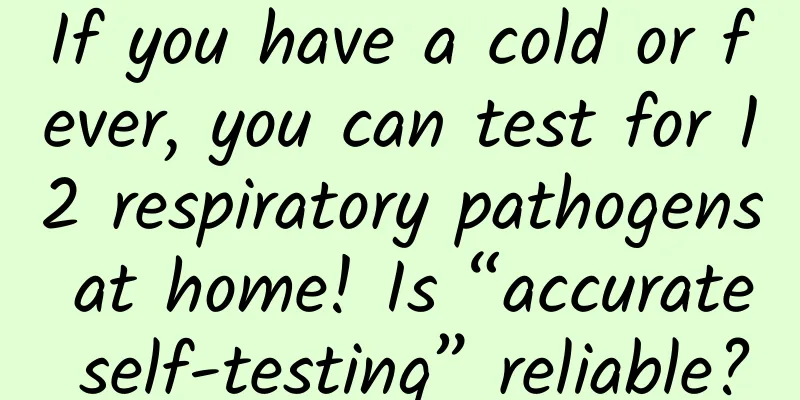If you have a cold or fever, you can test for 12 respiratory pathogens at home! Is “accurate self-testing” reliable?

|
At present, we are still in the high season of respiratory diseases, and there will continue to be a trend of alternating or co-epidemic of multiple respiratory pathogens. Some people just have a slight cough and don't want to go to the hospital to queue up and face the risk of cross-infection; some people have been in contact with susceptible people and are worried that they will be "infected" - how can we quickly find the cause of the disease? Many people have turned their attention to the door-to-door sampling respiratory virus and bacteria testing on e-commerce platforms. The "12-component home test for respiratory viruses and bacteria" service, which comes at your doorstep within 90 minutes, is tested by a professional testing agency and results are available within 3 hours. It has now covered many cities including Beijing, Shanghai, Hangzhou, and Guangzhou. Such a convenient and fast home health testing service has alleviated the shortage of medical resources to a certain extent, but can we really rely solely on the results of self-tests to "take the right medicine for the right condition"? Copyright image, no permission to reprint 01 You can know what virus you are infected with without leaving your home. Is the result reliable? This type of test sounds a bit similar to the door-to-door nucleic acid test during the COVID-19 period: the nucleic acid test is conducted by medical staff going to the door of potentially infected people to collect samples using sterile swabs, and the collection site is the nasal or throat secretions for antigen testing. Image source: an e-commerce platform In the promotion of e-commerce platforms, we can see that this respiratory virus and bacteria test has a wide range. It can test 6 to 17 pathogens at a time. In addition to influenza and mycoplasma pneumonia, there are also adenovirus, syncytial virus, rhinovirus, etc. Second, it is convenient and fast. The appointment process shows that after the user places an order, he chooses to make an appointment for door-to-door sampling. The staff (e-commerce deliveryman) will come to the door and wait for the user to follow the instructions. After that, the sample will be taken and sent for inspection, and the results can be directly checked on the mobile phone. In the past, if you felt unwell, you had to go to the hospital to queue up for registration, wait for the doctor to issue a test order, and then queue up (or make an appointment) for the test. Now, patients can test pathogens at home by themselves, which can quickly and conveniently understand whether they are infected with the virus, reducing the number of medical visits and waiting time. However, there is a certain gap in the accuracy of antigen and nucleic acid test results, and it is necessary to pay close attention to changes in the condition and conduct combined analysis. 02 If the test result is positive, is it necessary to seek medical attention or treatment? When the test result is positive, it usually means that specific pathogen RNA or DNA is present in the sample. However, not all positive results directly mean that the individual has the relevant disease. In some cases, especially in asymptomatic infected people, a positive result may only represent viral remnants rather than active infection, which is called a "false positive." Or, in the case of "colonizing bacteria" such as Streptococcus pneumoniae that have long lived in our respiratory tract, even if the test is positive, it is not necessarily the direct cause of symptoms such as fever and cough. In this case, a comprehensive analysis of clinical symptoms and signs is required. Of course, the detection method, sampling quality, etc. can also lead to "false positive" test results, usually in the following situations: 1. Improper operation: When conducting virus detection, the swab with the specimen is placed in the extraction tube containing the preservation solution for mixing and squeezing, and then dripped vertically into the detection hole. If the operation is not standardized during this process, the specimen result may be affected by the pH value and cause errors. 2. Specimen contamination. During the first virus or antigen test, if the sample comes into contact with other objects or is exposed to the air for too long after collection, the sample may be contaminated, resulting in erroneous results. 3. Currently, viral antigen detection is used as a supplementary method for viral nucleic acid detection. It allows a certain degree of tolerance in sensitivity, and false positives may appear in the test results. Similarly, it will naturally lead to "false negatives". For example, for influenza virus, the amount of influenza virus in the nasopharynx is highest within 24-96 hours after the onset of symptoms. The probability of getting a positive result is the highest if the sample is collected for testing during this period. If the sampling method is incorrect, or only the oropharyngeal swab is collected, it is also likely to lead to a false negative result. Therefore, a positive or negative result does not always mean that emergency medical treatment is needed or that the condition should be ignored. Patients are advised to contact medical staff, who can conduct more detailed examinations or re-examinations based on the patient's symptoms, medical history, and other relevant information to provide a comprehensive and accurate diagnosis for the patient. Antibiotics should not be used when bacteria are seen, and antivirals should not be used when viruses are seen, which may lead to overtreatment or delay of the disease. 03 Key points: If you are in the following situations, you can consider doing a "package" self-examination at home From a clinical perspective, not all respiratory pathogens will cause severe respiratory symptoms (for example, although the common cold virus can cause mild symptoms, the patient can recover without special treatment), so not all cold or fever symptoms require screening for respiratory pathogens. Generally, young people or those with strong immunity and mild symptoms do not need to take the initiative to undergo respiratory pathogen testing. However, you may consider testing if: (1) Patients with severe symptoms who are concerned about cross infection. If the pathogen test is positive at home, they should seek medical treatment in time. After the diagnosis is confirmed, they should strictly follow the doctor's instructions for treatment to ensure that the condition is effectively treated. If the test is negative, it is recommended to closely observe the changes in symptoms. If the symptoms continue to worsen or do not improve, it is still recommended to go to a medical institution for further examinations and treatment. Copyright image, no permission to reprint (2) The elderly, children, and patients with underlying diseases. Some respiratory viruses are often associated with other complications. For such people, if they have similar symptoms but are in a better mental state, identifying the pathogen as soon as possible and implementing precise treatment are very helpful for the treatment of respiratory diseases. With the popularity of cross-border tourism between the north and the south, and the upcoming winter vacation and Spring Festival travel, we will face large-scale movement and gathering of people, which is likely to accelerate the spread of respiratory diseases. When dealing with such viruses, people should learn and master relevant scientific knowledge, correctly and rationally understand respiratory pathogens, and take a series of preventive measures, such as keeping warm, wearing masks, avoiding crowded places, vaccination, regular medication, regular follow-up, and developing healthy living habits, such as maintaining moderate physical exercise, a balanced diet, adequate sleep and a good attitude, reducing stress, and improving the body's immunity, which are key measures to prevent and resist respiratory diseases. author: Yan Yusheng, Chief Physician, Department of Respiratory and Critical Care Medicine, Changsha First Hospital Li Nannan is a second-level researcher at the Hunan Association for Science and Technology and a director of the Hunan Science Writers Association. Reviewer: Chen Yuefei, Researcher, Member of Hunan Science Writers Association Produced by: Science Popularization China Produced by: China Science and Technology Press Co., Ltd., China Science and Technology Publishing House (Beijing) Digital Media Co., Ltd. |
<<: Why does "Laba Garlic" turn into "Miserable Green Boy"? Eating Laba Garlic has so many benefits!
Recommend
The underlying logic of Kuaishou live streaming sales from Simba’s sales
In the Double Eleven battle that ended not long a...
New media operation: 4 suggestions on new media writing!
On the one hand, self-media people write public a...
9 Strategies for Optimizing E-Commerce Product Details Pages
Consider the following scenario: Let’s say you ar...
Beware! Don’t touch this kind of “milk tea cup”
Recently, there has been a Outer packaging Toys s...
Tik Tok Kuaishou Ancient Painting and Singing Money Making Project
Douyin Kuaishou Ancient Painting Singing Money-Ma...
Is the "green" bean soup you drink red or green?
In the hot summer, many families will cook a bowl...
How to distinguish between Douyin information flow delivery and Douyin+?
According to official statistics, the official da...
Brand live streaming sales strategy!
From November 15th to 16th, L'Oreal was on th...
Tips for setting up a Toutiao advertising promotion account!
The information flow of Toutiao is becoming more ...
The programmers with the highest average income are not from the United States
[[150977]] The latest survey by MyHiringClub.com ...
4 key points and misunderstandings of refined operations in 2020
2020 is the year when online consumer demand has ...
Case sharing: How to use red envelope fission promotion to increase APP downloads?
The gameplay of the expanding red envelope is ver...
The most comprehensive big data analysis and production tools in history, get it!
The following are some "must-have tools"...
Guizhou researchers discovered an ancient creature 600 million years old. Has "SpongeBob SquarePants" been found?
Science Fiction Network, December 7 (Xu Mingyang)...
What is it like to have a 2GB per second internet speed? !
2GB Internet speed! That means downloading a high-...









